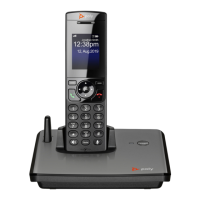45
Service Providers
Use the following information for SIP-based configurations. Each ITSP configuration is grouped together as
an ITSP profile. The VVX D230 refers to them as ITSP Profile A through ITSP Profile H.
Voice Services
● SP1–8
● OBiTALK
SIP Service Provider Features
You can configure up to four SIP accounts or SIP Trunks on the device. For the purposes of this guide and
elsewhere on the system web interface, documentation, and the OBiTALK portal, the term ITSP describes
the logical entity providing the SIP Trunk service to the device. When the device is used with an IP PBX, the
IP PBX takes the place of the ITSP if it is the entity providing the SIP Trunk account credential and
connectivity to the device.
Each ITSP configuration is grouped together as an ITSP Profile, referred to as ITSP Profiles A, B, C, and
D. On the other hand, the SP service account specifics are grouped under the heading SPn Service, where
n = 1–8. An ITSP Profile includes such parameters as ProxyServer, OutboundProxy, and DigitMap, but
doesn’t include account-specific parameters. An SP Service includes account-specific parameters such as
AuthUserName (usually the phone number of the account), AuthPassword, CallerIDName, and
X_ServProfile (which ITSP Profile to assume). If the SP Services use the same ITSP, then only one ITSP
Profile needs to be configured with all SP Services referred to the same profile.
From the device point of view, the SPn Service using ITSP Profile X is enabled with the following minimal
settings:
● ITSP Profile X – SIP::ProxyServer = Not Blank
● SPn Service::Enabled = Yes
● SPn Service::AuthUsername = Not Blank
where X = A or B, n = 1–8. Otherwise, the service is considered disabled.
SIP Registration
Devices can be set periodically register with a SIP Proxy Server or SIP Registration Server. SIP Proxy
Server and SIP Registration Server can be different, although they are usually the same in practice. SIP
Proxy Server is a required parameter that must be configured on the device. The Registration Server is
optional and assumed to be the same as the SIP Proxy Server if it isn’t configured on the device.
The main purpose of registration is to create and maintain a dynamic binding of the SIP account to the
device’s local contact address. The service provider can also rely on this periodic message to infer if the

